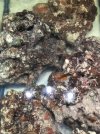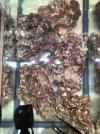Hi folks, yesterday I got some premium aquacultured live rock shipped overnight to me in water. I found some live crabs, trochus snails, feather dusters and worms on the rocks.
These rocks are pretty expensive (15lbs for $260) and I put them in a 10 gallon tank with air pump, waver maker, a heater and a Kessil 60 to provide 5 hours of gentle light. I have a few questions:
1. After 12 hours in my quarantine tank, I noticed some die-offs, including feather dusters, a variety of worms and pods with their dead body circulating in the water column, and the ammonia level is shooting 1 ppm even after 100% water change. What should I do to maximize the survival of all the lives on the rock? I tried to rub a died sponge / coral off the rock but failed, only creating a massive amount of mucus.
2. This live rock is about 15 lbs, and I have 40 lbs pound of dry rock in an established tank for about 6 months. How likely will the beneficial bacteria and other species on my new live rock be outcompeted by the existing algae/bacteria in my established system? I've heard people typically use quality live rock to seed new systems, not established ones.
Thanks!
These rocks are pretty expensive (15lbs for $260) and I put them in a 10 gallon tank with air pump, waver maker, a heater and a Kessil 60 to provide 5 hours of gentle light. I have a few questions:
1. After 12 hours in my quarantine tank, I noticed some die-offs, including feather dusters, a variety of worms and pods with their dead body circulating in the water column, and the ammonia level is shooting 1 ppm even after 100% water change. What should I do to maximize the survival of all the lives on the rock? I tried to rub a died sponge / coral off the rock but failed, only creating a massive amount of mucus.
2. This live rock is about 15 lbs, and I have 40 lbs pound of dry rock in an established tank for about 6 months. How likely will the beneficial bacteria and other species on my new live rock be outcompeted by the existing algae/bacteria in my established system? I've heard people typically use quality live rock to seed new systems, not established ones.
Thanks!
Attachments
Last edited:



